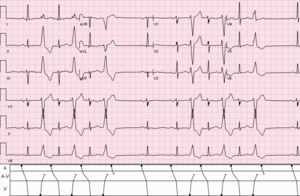Medicine:Concealed conduction
Concealed conduction is tissue stimulation without direct effect, but leading to a change in conduction characteristics.[1]
A common example would be an interpolated PVC (a type of premature ventricular contraction) during normal sinus rhythm; the PVC does not cause an atrial contraction, because the retrograde impulse from the PVC does not completely penetrate the AV node. However, this AV node stimulation can cause a delay in subsequent AV conduction by modifying the AV node's subsequent conduction characteristics. Hence, the P-R interval after the PVC is longer than the baseline P-R interval.[citation needed]
Another variation on this concept is seen in atrial flutter. As a result of the rapid atrial rate, some of the atrial activity fails to get through the AV node in an antegrade direction but can alter the rate at which a subsequent atrial impulse is conducted. In this circumstance, an alteration in the F-wave to QRS relationship is seen.[citation needed]
See also
- Atrioventricular node
- Electrocardiogram
References
- ↑ Josephson, Mark E. (2008) (in en). Clinical Cardiac Electrophysiology: Techniques and Interpretations. Lippincott Williams & Wilkins. p. 145. ISBN 9780781777391. https://books.google.com/books?id=0Q--epKpkWYC&q=Concealed%20conduction&pg=PA145. Retrieved 24 September 2018.
 |


